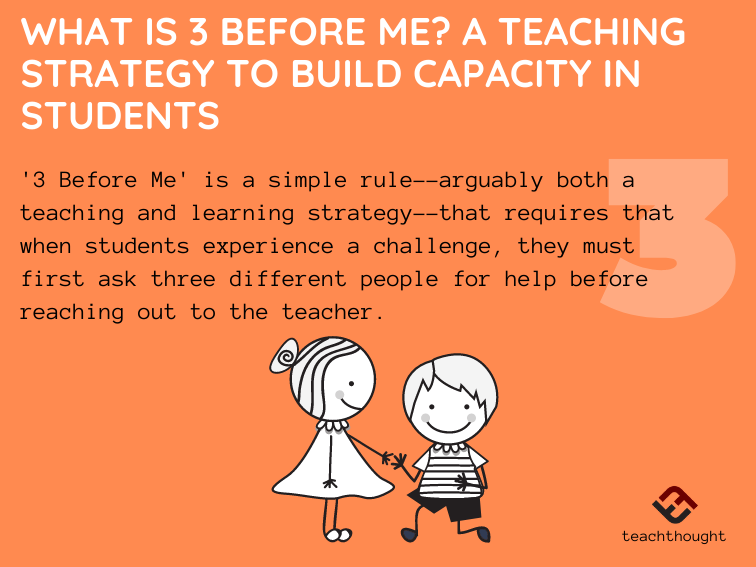
3 Before Me: A Teaching Strategy To Build Capacity In Students
by TeachThought Staff
What is ‘3 Before Me’?
‘3 Before Me’ is a simple classroom strategy–arguably both a teaching and learning strategy–that requires that when students experience a challenge, they must first ask three different people for help before reaching out to the teacher.
An evolution of that strategy? When students become ‘stuck,’ they must first try to solve the problem in three different ways before asking the teacher. This makes it more flexible. You can require students to ask one person and seek two resources or two people and one resource. You also can group students in your classroom and require students go to one person from three of the groups. (You can group by general ability, content area, social factors, etc.)
Students’ ability to solve problems both independently and collaboratively is a crucial component of a modern, efficient classroom. When students get ‘stuck’ or aren’t sure where to go or what to do next, the teacher is generally the first place to go. But in a classroom–whether digitally connected or not–they often can solve the issue on their own or get assistance from multiple sources. To truly empower students in this age of information requires that we develop in students the capacity, willingness, ability, and tendency to navigate complex tasks and information.
And this ‘rule’ is a simple way to start.
What Does ‘3 Before Me’ Require?
Of course, this approach requires that students develop a growth mindset (i.e., that they believe that they can) and practice over time to build it as a learning reflex. It also requires there to be actual ‘answers’ in the classroom: more knowledgeable students, books, a search engine, encyclopedias, etc. The ‘stuck’ doesn’t have to be academic, obviously. If it’s a matter of classroom process, procedure, or direction, ‘3 Before Me’ is more immediate and effective. If the problem is based on skills or content knowledge, the likelihood of the teacher needing to get involved is still higher but is still less than 100% (as it is before using a strategy like this).
Over time this approach can be a good starting point for converting students from ‘learn to do’ to ‘learn to do well.’ Of course, there may still remain ‘areas for growth,’ which is why the holistic ‘learning + others + caring’ approach that accompanies ‘3 Before Me!’ is vital. Beyond mastery of content knowledge and the ability to think critically, students also need time (both experientially and temporally) to grow in other areas and build capacity as readers, writers, and thinkers–that is, as ‘students.’ We learn more in relation to and alongside our peers rather than being compared to them.
Only through growth and independence from institutions and adults can we create a society that can actually affect change–grow and solve persisting challenges. To evolve rather than reproduce itself. Progressive teaching and learning models need to be ‘people first’ and focus on helping individuals develop their capacities to identify solve problems on their own. Of course, ‘3 Before Me’ isn’t a world-changing tactic. It’s simply a step toward student self-directed learning built around a self-organized learning environment.
Conclusion
In schools, students often learn in relation to books and adults rather than in relation to nature, objects, or other surroundings. Instead of describing learning in terms of degrees of understanding, depth, or complexity, we identify achievement as relative and evaluate learning through subjective evaluations of how well students did relative to specific learning objectives rather than how well they identified problems, sought resources, persevered through uncertainty and, over time, built learning literacy (i.e.g, learning how to learn)
While ‘3 Before Me’ isn’t always ‘solving complex problems’ about ‘understanding,’ the consistent use of it over time can help students achieve understanding in ways that create a more sustainable learning environment for both teachers and students.
What Is 3 Before Me? A Teaching Strategy To Build Capacity In Students